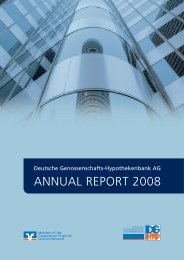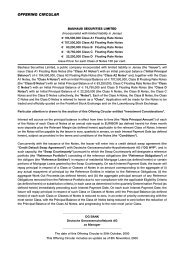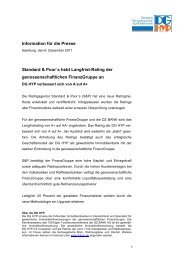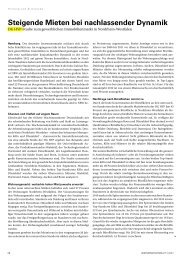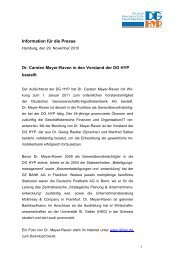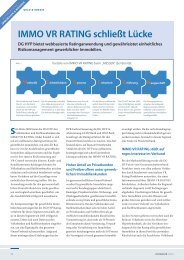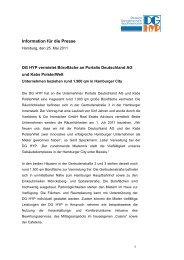Covered Bonds - DG Hyp
Covered Bonds - DG Hyp
Covered Bonds - DG Hyp
Create successful ePaper yourself
Turn your PDF publications into a flip-book with our unique Google optimized e-Paper software.
<strong>DG</strong> HYP COVERED BONDS – PFANDBRIEFE – QUALITY THE PATH OUT OF THE CRISIS SPECIAL MAY 2009<br />
Pfandbriefe – Quality the path out of the crisis<br />
Market overview – where we have come from, where we are now<br />
Structurally, it feels right now as if no stone has been left standing on another in the covered<br />
bonds market. Pfandbriefe have been suffering a deep crisis of confidence ever since the<br />
financial-market turmoil erupted. The article of faith that has been most called into question<br />
is the protection afforded to creditors in the issuer-insolvency scenario through the ringfencing<br />
of the cover assets– historically one of the main marketing arguments for covered<br />
bonds and pfandbriefe. And the downturn of several key property markets (first and<br />
foremost the USA of course, but also the UK, Spain and Ireland among others) has also<br />
suddenly hung a question mark over the quality of cover assets and therefore the very<br />
safety of covered bonds. Initially, pfandbriefe were spared the spreading loss of trust that<br />
found expression in rocketing swap spreads. But now even German pfandbriefe, the original<br />
covered bonds, have also caught the infection – with unjustified severity, as we will see.<br />
Dwindling trust and a more critical attitude towards covered bonds on the part of investors<br />
are now likely in the long term to produce a total re-think in the way pfandbriefe are valued<br />
and treated, and by extension also cause a step-increase in the swap spreads investors<br />
demand to compensate their risk. And this development should also be welcomed: we<br />
pointed out on many occasions before the crisis erupted that investors‘ previous – in our<br />
view superficial – analysis of covered bonds, which essentially added up to blind faith in<br />
ratings, had brought about a market situation that was anything but healthy. The exceptional<br />
homogeneity of pre-crisis swap spreads was not the only evidence of this neglect.<br />
The current market phase will blaze a new trail into the future for covered bonds. We need<br />
to set the points now to create a sound foundation for the sustained healthy operation of<br />
both the secondary and primary markets. Issuers, investors and covered bond dealers (the<br />
word market maker no longer seems quite adequate to us) need to create an environment<br />
that restores confidence – on every front simultaneously. And even if some in the market do<br />
not wholly share our view: it is to be hoped that the market does not return to normal too<br />
quickly. If it did, a sudden explosion of issuing and trading activity could well cause the so<br />
desperately needed reorganisation of the market to be tackled half-heartedly so that all<br />
involved ended up falling back into their old ways. If this happened, it would probably be<br />
only a question of time until the covered bonds market – and by extension also the<br />
pfandbrief segment – slid into another crisis of confidence.<br />
In the years gone by, many investors treated covered bonds and especially pfandbriefe as<br />
Bund surrogates – principally because of the outstanding liquidity they offered thanks to<br />
market making. They ignored covered bonds‘ inherent credit risk (arising from their cover<br />
pools) when valuing issues. This attitude also caused them to regard all the issues that<br />
came to the market as „cut from the same cloth“ without any in-depth analysis, and find<br />
almost every offering acceptable. The consequence was swap spreads that were virtually<br />
identical from one segment to another. As Bund surrogates, all covered bonds benefited<br />
from the strength of demand that the supply of fresh bonds was never enough to satisfy.<br />
This meant that when the crisis broke out, the markets‘ negative reaction was all the<br />
stronger as the realisation gradually spread that investors should have paid more attention<br />
after all to cover pool quality and issuer ratings. Having said that, we do believe the reaction<br />
was excessive; it frequently appears to us to be the case that the issuer rating is now almost<br />
the only factor considered, with say the cover pool‘s quality characteristics and the<br />
underlying legal framework now playing no part in the decision-making process.<br />
Deep‐rooted skepticism towards<br />
covered bonds<br />
Valuations being fundamentally re‐<br />
thought<br />
Restoring trust the most important<br />
objective<br />
Credit risk was previously ignored...<br />
... but now is becoming top‐priority<br />
2





